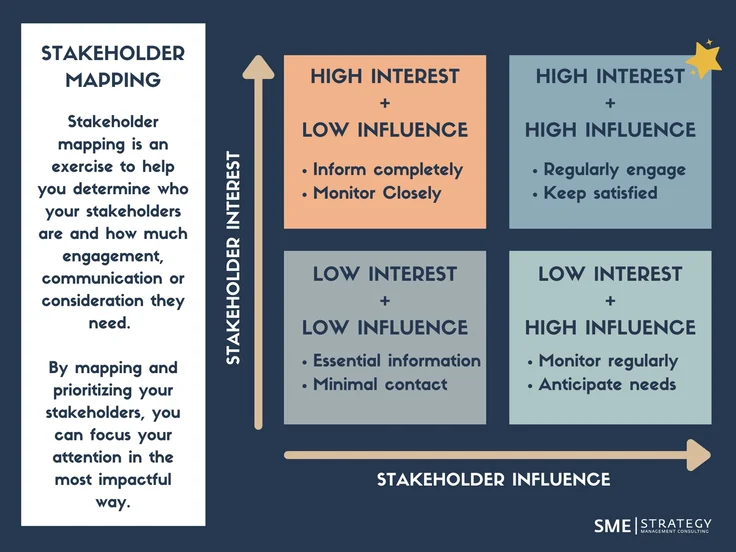Stakeholder engagement is the heartbeat of successful businesses. Organisations need to make meaningful connections in a world where information flows freely, and stakeholders have a more significant say. Good communication is key. Therefore, businesses are changing the way they connect with stakeholders.
Why is stakeholder engagement so important? Companies with employee engagement schemes outperfrom other firms by 54% in employee retention, by 89% in customer satisfaction, and by fourfold in revenue growth.
In this article we’ll explore why stakeholder engagement is crucial, analyse the top trends influencing this landscape, share practical tips for effective communication, and highlight effective examples.
Why is stakeholder engagement important?
Stakeholder engagement is not just a buzzword; it’s a strategic necessity. Here are compelling reasons why businesses should prioritise and invest in stakeholder engagement.
Complex stakeholder paths: Unlike the straightforward journey of customers in a sales pipeline, stakeholders follow a more complex path. Understanding this complexity is crucial for long-lasting success when creating your stakeholder management plan. For example, a software company launching a new product must involve investors and a group of stakeholders, from initial pitches to ongoing updates.
Building relationships: Effective stakeholder engagement is about building and nurturing relationships. Businesses can gain insights, foster trust, and create a positive reputation by establishing connections with stakeholders.
Influence on decision-making: Stakeholders often hold significant sway in decision-making processes. Engaging with them ensures that their perspectives are considered, increasing the likelihood of successful outcomes.
Risk mitigation: Proactively engaging with stakeholders will allow your business to identify and address concerns before they escalate. This strategic approach will help mitigate risks and prevent potential crises.
Top trends in stakeholder engagement
1) Turn critics in allies
In today’s digital era, businesses are changing how they handle critics – aiming to turn them into allies. Instead of dodging criticism, companies are diving into dialogue.
Engaging with naysayers on social media and online forums isn’t just about reputation; it’s creating a culture of continuous improvement. Setting up a proper stakeholder engagement and communication plan for addressing critics can significantly increase stakeholder engagement.
2) Shifting away from top-down communication
Forget about the old-school top-down communication style. Information is free flowing and businesses can no longer control the narrative so we’re seeing more companies adopt two-way communication strategies.
This approach helps you understand stakeholder perspectives, interests, and concerns. Two-way communication enhances credibility, transparency, and accountability, reducing misunderstandings or conflicts. It’s not just about meeting expectations; it’s about being authentic and conversing with your audience.
3) Communicating with stakeholders is an around-the-clock job
Stakeholder engagement isn’t limited to 9-5 anymore – it’s a 24/7 commitment. Modern stakeholders expect instant access to information and quick responses, reshaping organisational communication dynamics. Businesses are adapting by using advanced tools like chatbots and automated email systems.
Platforms like Vision6 can automate transactional emails, ensuring ongoing engagement with employees and stakeholders. This proactive approach keeps stakeholders well-informed and streamlines overall communication processes.
4) It’s a top priority for senior management
Stakeholder engagement is not just another checkbox. It’s a top priority for senior management. Leaders recognise its pivotal role in overall success.
With increasing regulations related to stakeholder engagement and corporate responsibility, senior management understands the importance of staying ahead. Proactive engagement ensures compliance and positions your organisation as a responsible and ethical entity.
How to increase stakeholder engagement:
Email is the best internal and transactional communication method between employees, stakeholders, and customers. Integrating it into your stakeholder engagement plan can solve numerous challenges. Here are a few tips for using emails to effectively communicate with your stakeholders.
1) Set clear goals
Establish clear communication goals as the foundation of your stakeholder engagement. Avoid adding multiple topics to one email and ensure readers know exactly what to do.
Short, direct subject lines and a single call-to-action can drastically improve open and conversion rates. Experts suggest that emails with a short and direct subject line and a single CTA can increase open and conversion rates by 371%.
2) Send a regular newsletter
Consistent communication is key. Regular newsletters inform stakeholders about the latest developments, initiatives, and achievements. Implement a monthly digital newsletter that covers all the major events, news, results, and other information in a condensed manner.
Make sure you divide it into multiple sections and give equal weightage to each based on department, function, or other categories. This ongoing connection helps maintain engagement over the long term.
3) Don’t over-communicate
While regular communication is essential, avoid overwhelming stakeholders with too much information. Find a balance between keeping them informed without over-explaining situations with unnecessary details.
Regulate the frequency and volume of communication to align with the average daily email load to ensure your important messages are noticed. People usually open emails from brands that they don’t see in their inboxes every day.
4) Ensure a fast response rate
In the digital age, responsiveness is non-negotiable. Timely responses demonstrate a commitment to stakeholder satisfaction. When you send automated emails to stakeholders, setting a response strategy is essential. Whether manual or automated, ensure a fast response rate to inquiries, feedback, and concerns.
5) Map stakeholder relationships and track issues
Not all stakeholders require the same level of attention. Some stakeholders wouldn’t even be as interested as others. Similarly, some would have more influence than others. Therefore, spending time and effort where it matters more is important while allocating less attention to others.
Utilise tools like the Vision6 platform’s lead-scoring solution to map stakeholder relationships and track issues. This data-driven approach allows targeted and personalised communication, enhancing efficiency. Coupling this with automated transactional email sequences, you have a powerful, resource-efficient stakeholder communication system. Finally, measure the ROI for each mapping and refine the model.
Below is an example of classifying stakeholders based on interest and influence.

6) Make communication two-way
Encourage feedback and seek opinions from stakeholders. Two-way communication fosters collaboration, ensuring all stakeholder perspectives are equally considered. Involving stakeholders in real-time through calls-to-action and response links can enhance trust and influence.
If you’re needing to loop in stakeholders on critical comms you can use Vision6 platform’s Email Feedback feature, where they can provide comments and feedback.You can also make use of Vision6 forms to get feedback stakeholders. All responses are responses are automatically collated in your Vision6 account and easy to export as a spreadsheet.
That being said, two-way communication should work complementary to stakeholder mapping. Not everyone needs to be involved in the feedback loop. Clearly define who’s part of the feedback loop and two-way channel and automate the channels accordingly.
7) Create a community for informal communication
In addition to formal channels, create a community for informal communication. This space allows stakeholders to connect, share insights, and build relationships outside structured communication.
For a healthy growth environment for your business, you need to foster a culture where people are not afraid to raise objections, share opinions, and give constructive feedback. This can only be achieved through an informal communication channel. Informal channels also introduce more flexibility, better relationships, better chances of resolving conflicts, and higher efficiency.
8) Show and tell with video updates
Incorporate video updates into your communication strategy. Visual content is engaging and provides a personal touch, allowing stakeholders to connect with the human side of your organisation. Majority of people understand information better when communicated visually.
Stakeholder engagement strategy
Here’s an example of an effective stakeholder engagement strategy to help you get started:
1) Identify stakeholders
Objective: Recognise and understand the different stakeholders and their roles and interests in a project.
Why: Identifying key stakeholders ensures inclusivity, allowing all relevant parties to be involved in project discussions and decision-making.
2) Communicate effectively
Method: Opt for one-on-one discussions for important matters and group meetings for broader discussions.
Why: This approach is more effective for aligning everyone to project goals and objectives.
3) Acknowledge stakeholder contributions
Approach: Ensure everyone understands project goals to encourage motivation and optimal contributions.
Why: Recognition keeps stakeholders committed to the overarching objective of the communication.
4) Create a communications plan
Plan: Develop a detailed plan that addresses stakeholder information requirements, update frequency, and their preferred communication channels.
Why: A comprehensive communication plan ensures effective communication tailored to stakeholder expectations.
5) Log meetings with stakeholders
Use Tech: Leverage the power of a digital database to record meetings.
Why: This will improve engagement by maintaining a transparent record of ongoing improvement initiatives.
Final takeaway
Stakeholder engagement is an important strategy that goes beyond traditional communication. To succeed in the digital age, businesses must understand this importance, keep up with changing trends, and use effective communication tips. As stakeholders wield increasing influence, organisations that prioritise meaningful engagement utilising powerful platforms like Vision6 will undoubtedly thrive.
The Vision6 platform’s advanced email automation and collaboration features can make your stakeholder engagement a walk in the park. Map your stakeholders and score their engagement with our lead-scoring capabilities while automating your transactional emails with custom and pre-built templates.


